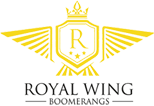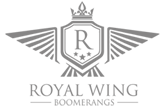Instructions for boomerang handling
Everything always looks so easy in the videos, or when an experienced expert throws and catches a variety of boomerangs. However, the reality is different, because boomerangs only really come back if the wind is right, inclination angle, horizon angle, angle angle and force. Assuming that it is really a correctly profiled model in the right weight ratio. This is why some low-cost department store versions only fly straight. So it’s not always just the thrower. EVERY Royal Wing boomerang, on the other hand, is tested beforehand and has also been caught. There are many videos on the Internet where all litters can be caught without any problems. But you have to ask yourself this, why should boomerang owners show their many false positives and unsuccessful attempts to catch them? Too many factors determine whether a boomerang can be caught or not. However, the probability increases in any case with the appropriate practice. Practice creates masters. The price has no influence on whether you will catch it. For example, you would hardly be able to catch a Royal Wing boomerang with tailwind, sickle throw, winds that are too strong and gusty, etc.
Safety:
Security is always a top priority and should not be neglected. Some principles should therefore be strictly observed:
- Keep a sufficient distance from other people, animals, trees, houses, objects, etc. A short-cut lawn or meadow would be ideal. Generally it is advised to add at least 50% to the possible distance of the boomerang. If the throw distance is around 30 meters, then you should keep a safe distance of 45 meters. At least as I said. The more space available, the better and safer it is.
- It is no problem to go throwing with other boomerang friends. However, only one person should throw a boomerang whenever possible, everyone else should follow it during the flight so that they can avoid it in an emergency. A wild mess would greatly increase the risk.
- Boomerangs reach high speeds and rotate strongly around their own axis. Even small and light models can cause injuries. Therefore, you should be particularly careful with the large and heavy Royal Wing boomerangs. With proper handling, the risk of danger is low.
- The use of boomerangs is always at your own risk. The manufacturer or seller assumes no liability for damage caused by improper use or misuse.
- If you have the feeling that the boomerang is approaching you in a threatening way, for example after you have not thrown it optimally, then you should not try to catch it. A boomerang can only be caught risk-free if it approaches you at a moderate pace, ideally floating down. Otherwise, avoid it and try again with a better throw.
- The rotating wings can lead to bruises and painful bruises if you are “caught” unhappy trying to catch them. This can happen even to experts occasionally. If you want to further reduce this risk, we recommend wearing half-fingered cycling gloves. This means that you have a little less feeling when dropping, but bumps are absorbed by the upholstery.7. Please do not throw with damaged or opened boomerang. Not even when the wind is too strong. Usually you can throw boomerangs up to a wind force of 3-4. Special wind boomerangs up to 5, but then it’s over. To have a better idea, wind force 4 is a moderate breeze, where twigs and thin branches move, leaves are whirled up from the ground.
- Avoid the dangerous sickle throw. The boomerang flies forward a short distance, but then rises almost at a right angle to then plunge down at the launcher. In this case the angle of inclination was much too large and almost 90 degrees parallel to the ground. Normally the angle of inclination is 0-30 degrees depending on the boomerang, with special hook shapes sometimes up to 45 degrees.
- Always keep an adequate safety distance to the rear.
Wind influence
Beginners somehow just throw the boomerang somewhere and wonder that it won’t come back. The wind is also very important and must be taken into account. First you control the wind direction exactly by tearing off some grass and letting it trickle down with your hand raised. Now align it head-on. Starting from this position, turn approx. 40-70 degrees to the right. Almost all boomerangs can be thrown within this spectrum. Trying something out is of course part of it, because each model is thrown differently individually. We have already caught litters at 90 degrees. If you stay within this range of 40-90 degrees at the wind angle, then you have at least a good starting point and can optimize the throw based on it.
The wind force must also be taken into account. It is difficult to throw boomerangs when there is too much wind, but also when there is no wind at all. A wind force of approx. 1-2 would be perfect
Throwing technique:
Inexperienced throwers can throw for hours without being able to catch the boomerang. So it’s not that simple. Galileo shows a very nice report with the article “Can I learn to throw a boomerang in one day?”. https://www.prosieben.de/tv/galileo/videos/2015-kann-ich-einen-bumerang-werfen-clip You shouldn’t be discouraged, some learn it faster, some are “natural talents”, etc. Practice make the master. The more practice you have, the better the boomerangs come back, and the more fun the whole thing is, of course.
Tilt angle
The angle of inclination differs depending on the boomerang and is approx. 0-30 degrees, in exceptional cases e.g. with some hook models also up to 45 degrees. To do this, hold the boomerang on the limb and on the side in front of you. Now the right-handed boomerang is tilted to the right as a right-handed person. Left-handed people tilt the left-handed boomerang to the left.
Horizon angle
The horizon angle describes the forward discharge, which should be approximately 5-15 degrees from the ground. Roughly said, throw it forward and slightly upwards with sufficient force.
Wind angle
See section Wind Impact. The wind angle is usually 40-70 degrees, but can sometimes be up to 90 degrees. If you are within this range, there is a high probability that you will catch the boomerang.
To catch
There are many ways to catch a boomerang. The best and easiest method is to “clap” flat with your hands and pinch from top to bottom. Otherwise you can experiment and increase the level of difficulty. For example, catch with one hand. Catch behind the back, between the legs, etc. Definitely not want to catch everyone on an incoming boomerang, but only when it has slowed down and at best floats down like a helicopter. What to catch depends on experience, risk taking and courage. For beginners, semi-fingered cycling gloves are recommended to reduce the risk of injury to the hands.
Tuning
The flight characteristics are roughly predetermined by shape, weight, size, etc. Nevertheless, you have a certain influence with tuning. You bend the wing ends accordingly to correct the faulty flight. The whole should be done carefully, too strong pressure can lead to tears or breakage.
- The wings have warped. If the boomerang lies flat or if the wing tips are slightly up, then everything is fine. However, if these are bent down, this could be the cause of the problem. In this case you should bend the wing (s) under constant and moderate pressure for approx. 10 seconds. Repeat the procedure if necessary.2. If the boomerang does not match the launcher, you can possibly correct it with tuning. If the thrower is too weak, for example, you have to try to generate more lift so that it describes a smaller throw circle. In this case, you can slightly bend the wings, possibly also twist them a bit around the axis. To do this, place your thumb on the slanted edge and index finger on the front edge, then pull your index finger towards you.
The following note applies when tuning.
- If you bend the wings up, the lift increases and the boomerang flies higher overall.
- If you bend the wings down, the buoyancy is reduced and the boomerang flies lower.
Arm 1 is responsible for the first half of the flight, while Arm 2 is responsible for the second half.
Possible errors
Left-handed and right-handed boomerangs
As a right-handed person, you cannot throw a left-handed boomerang and vice versa. Then he would not return. Most of the boomerangs on offer are always right-handed models. This is because the proportion of left-handers in the population is only 10-15%. Royal Wing Boomerangs can of course also offer left-handed models on request.
Boomerang warped
Wood is a natural product, which can warp if improperly stored or moist. If the boomerang does not fly reliably, you can easily check the condition. Place the boomerang on a flat surface. If it lies relatively flat so that you cannot see through anywhere, then it is fine. If the wing tips are slightly up, that’s also ok. This is a sign that more buoyancy is being generated. If the wings are bent down, the problem is probably because of that. Or if the wing tips are too high. So either relatively straight, or slightly upwards, then everything should be roughly right. When tuning, you otherwise bend the wings in the opposite direction under careful and persistent pressure (until you feel resistance, approx. 5 seconds).
Right side should face the launcher
The boomerang only comes back when the top is facing the thrower. With the Royal Wing boomerangs this is easy to determine, because the underside is the side with the gold, platinum or silver flakes. On the other hand, the gemstones can be seen on the top.
No rotation
In theory, you could actually throw a boomerang correctly, but with little or no rotation. In this case, hardly any lift is generated, so it will not come back. The handle or wrist plays a major role here. Before dropping, the wrist is bent backwards. When dropping itself, the hand with the joint is quickly accelerated forward like a spring. This sets the boomerang in strong rotation and enables the buoyancy effect in the first place. Without the rotation impulse, it will only fly forward.
Care Tips
- The colder the higher the risk of breakage. Throwing boomerangs is NOT a winter sport. You rarely have good weather, but the cold also affects them. Boomerangs will not “glass” at low temperatures, but the risk of breakage increases rapidly. You shouldn’t take the risk.
- Lawn and meadows instead of beach and gravel. Soft substrates are to be preferred in any case, because sand, small stones, gravel, etc. very quickly cause many scratches in the paint. Signs of wear also appear on lawns or meadows over time, but much more slowly.
- You should definitely take off watches, rings, bracelets, etc., because metal is always harder than wood and lacquer. Deep scratches, nicks, cracks, flaking, etc. can be prevented in this way.
- Avoid tall grass. Even if you pay attention, searching in high grass can be quite nerve-wracking. With bad luck you will never find the boomerang again. Therefore, you should only throw where you can see the ground really well.
- Never leave the boomerangs in the blazing sun for long. Otherwise, the black paint would make them very hot, which could damage the paint. It is best to put it in the transport bag or cover it with a cloth.
Note: You are also welcome to watch our exercise videos.




